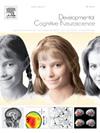电生理解码捕捉婴儿面部分类的时间轨迹
IF 4.9
2区 医学
Q1 NEUROSCIENCES
引用次数: 0
摘要
在刺激开始后,成年人的大脑会在170 毫秒左右迅速区分人脸。然而,在大脑发育的早期,人脸识别被认为需要几乎两倍的处理时间。为了重新检验这个长期存在的假设,我们在一个与事件相关的脑电图实验中向5到13个月大的婴儿展示了人类和非人类灵长类动物的面孔。利用基于逻辑回归的时间分辨解码技术,我们检测到在大约200 ms的时间窗口内,来自枕颞电极的人脸与非人脸的区分高于概率。然而,没有证据表明,个体人类或个体非人类的面孔存在高于机会的歧视。这些结果表明,在学龄前婴儿中已经出现了快速的面部分类。本文章由计算机程序翻译,如有差异,请以英文原文为准。
Electrophysiological decoding captures the temporal trajectory of face categorization in infants
The adult human brain rapidly distinguishes between faces at around 170 ms after stimulus onset. During early brain development, however, face discrimination is thought to require almost twice as much processing time. To re-examine this long-standing assumption, we presented human and nonhuman primate faces to five to thirteen-month-old infants in an event-related electroencephalography experiment. Using time-resolved decoding based on logistic regression we detected above-chance discrimination of human faces from nonhuman faces in a time window already starting at around 200 ms, originating from occipito-temporal electrodes. There was no evidence, however, for above-chance discrimination of individual human or individual nonhuman faces. These results indicate that rapid face categorization emerges already in preverbal infants.
求助全文
通过发布文献求助,成功后即可免费获取论文全文。
去求助
来源期刊

Developmental Cognitive Neuroscience
NEUROSCIENCES-
CiteScore
7.60
自引率
10.60%
发文量
124
审稿时长
6-12 weeks
期刊介绍:
The journal publishes theoretical and research papers on cognitive brain development, from infancy through childhood and adolescence and into adulthood. It covers neurocognitive development and neurocognitive processing in both typical and atypical development, including social and affective aspects. Appropriate methodologies for the journal include, but are not limited to, functional neuroimaging (fMRI and MEG), electrophysiology (EEG and ERP), NIRS and transcranial magnetic stimulation, as well as other basic neuroscience approaches using cellular and animal models that directly address cognitive brain development, patient studies, case studies, post-mortem studies and pharmacological studies.
 求助内容:
求助内容: 应助结果提醒方式:
应助结果提醒方式:


